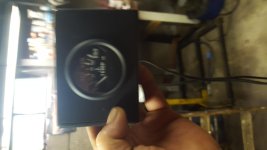""Question on the exhaust manifolds, exterior wise they look in good shape. I am assuming they have been worked on as the bolts look to have been removed somewhere along the line. The edges of the gaskets I can see are rusted, but there is no sign of water leakage from them on the outside nor at the block area. Do I dare take one off and see what I see, or just leave well enough alone. Again maybe another can of worms? ""
The concern is if the boat was in salt water when used by prior owner (s).
If it was that may explain why they look as they do.
If the boat was used in fresh water only then exhaust manifolds and elbows can last 30-50 years with no issues.
My boat is a 1987 and still has original exhaust manifolds and elbows and have never been removed/serviced.
I would leave them alone as there does not appear to be any issue at this point.
Your concerns have to be water tested under load and boat run at 1/2 to 3/4 throttle for a while to see if there are any issues with internal leaks.
Running on a trailer in neutral does not always show these issues.
As far as your floor.
Remove interior, pull floor out, Cut New Marine grade plywood to fit. You can encapsulate it in a fiberglass resin with loose fibers mixed in.
Sand everything smooth and install.
The mounting "Joists" that the new floor screws into may be wet so they may need to be sister-ed with fresh pressure treated lumber for a good surface to screw into.
I would strongly recommend re-carpeting the floor. Use new marine carpet and good marine carpet adhesive.
Go with a neutral color such as grey.
People like carpet under their feet.......No sliding around!! Also less chance of a beer bottle breaking if dropped....
"""Distributor and rotor had to have been replaced at some point but look old. the pickup sensor is not encapsulated, plug wires do look original if that is even possible from 92 but I have seen worse things before so guessing so? I did not pull the plugs but I plan to replace all of it either way."""
You should do as I recommended and replace everything (ignition) with new parts to start with a known good baseline. You wont regret it!!
I did so in my boat when I purchased it. My boat had only 250 hrs of use when I bought from original owner. I still replaced everything (Cap, rotor, sensor, wires, plugs) to start with all new baseline and that lasted over 12-15 years before I redid everything again as a preventative measure.
I redid all of again two years ago, again as a preventative measure....Cap, rotor, sensor (Encapsulated, three wire where the third wire is a ground) and high quality plug wires.
Use OEM or Sierra as shown below. The Sierra are a good wire!
I went with Sierra 18-8821-1 - Wire Set for my V8
Sierra 18-8810-1 for your V6


